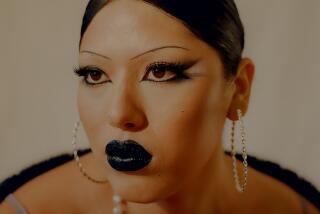The Will o’ the Wisp : Anyone Who Wears a Comb-Over Is Just Pulling the Wool Over His Own Eyes
- Share via
IT MIGHT reasonably be argued that the most sensitive portion of the male anatomy--above the belt, at least--is the dome of the skull. Certainly, it’s the spot that men are most determined to shield from society’s scrutiny. And when it’s suddenly exposed to the glances of a contemptuous public, there seems to be no limit to the pain and humiliation that balding men will endure to preserve the illusion that they’ve got just as much hair as the next guy.
Pity the poor skinhead. Ever since Samson got clipped by Delilah, hair loss has been associated with diminished virility. Yul Brynner, Telly Savalas and Isaac Hayes aside, bald men have few role models to emulate. No wonder so many of them resort to toupees, transplants, scalp-shrinking surgery and twice-daily applications of Rogaine. And why so many more practice the oldest form of deception: the comb-over.
The standard technique is to grow out the hair on one side of the head so that it can be combed over a bald spot and reunited with the surviving outpost of hair on the other side. Typically, the combed-over hair is secured by mammoth applications of heavy-duty mousse or hairspray. In the hands of skilled practitioners--Joe Biden, come on down!--comb-overs are testaments to man’s heroic, if contradictory, capacity for both guile and self-delusion.
Also known by such descriptive sobriquets as the Wraparound, the Blankie and the Up-and-Over, the comb-over dates back at least as far as Julius Caesar. Modern hair stylists, though, are doing their best to consign it to history’s dustbin. “The first thing a good stylist will tell you is that taking one strand (of hair) and wrapping it across and spraying it with cement looks ridiculous,” says Giuseppe Franco, who with actor Mickey Rourke owns a namesake salon in Beverly Hills. “When you go to that comb-over look, you’re not just losing your hair; you’re losing your mind.”
Nearly 40 million American men suffer from the hair-loss condition known as alopecia, of which male pattern baldness (hair receding from the temples and out from the crown) is by far the most common variety. In fact, studies have shown that 10% of all men start to experience visible hair loss in their teens, 20% in their 20s, 30% in their 30s and so on.
In the beginning, when bald areas still resemble counties rather than continents, only minor rearrangement is needed. But as the hairline recedes further and further, the remaining hair must be parted closer and closer to the ear. Over time, what had originally been a white lie matures into the enormous canard known as The Big Wrap.
The irony of the situation is that the more elaborate the comb-over, the less flattering the result. “My girlfriend told me to cut it off because it looked terrible when it was blown about by the wind,” says John Rettie, a Santa Barbara writer-editor who was so pleased with the au naturel result that he married his girlfriend. Says Clay Wilson, owner of the Doyle Wilson Salon on Melrose Avenue: “A comb-over doesn’t fool anybody but the person wearing it. It’s when you fight nature that (hair loss) becomes the most obvious.”
Making the leap from comb-over to combless--the Big Whack, as it were--is a nerve-racking step that’s probably best taken with the aid of a professional. A hair stylist also can recommend what to do next, whether it’s growing a mustache or a ponytail to deflect attention from a blinding pate or opting instead for a defiant bald-is-beautiful cut. Although there are no hard-and-fast rules, Franco offers this general principle: “I always say, ‘Go with it, not against it,’ ” he says. “If you’re receding, go short, not long.”
Balding for the past 20 years, Los Angeles-based photographer Bob Stevens recently went short, with unexpectedly pleasant results. “I just mow it down like a putting green,” he says. “People say it makes me look younger. I like it short so much that I get it cut every 10 days or so. After about a week, it starts to look unkempt, if you can believe it.”
Men sadly watching their hair being swept down the shower drain of life can take solace in the fact that arbiters of modern fashion have ruled that artifice is out. “These days,” Wilson explains, “it’s much more acceptable not to disguise imperfections. It’s considered more attractive to see where the hair isn’t.”
The change in style pleases no one more than John T. Capps III, founder of Bald Headed Men of America. Says Capps: “If you don’t have it, flaunt it.”


